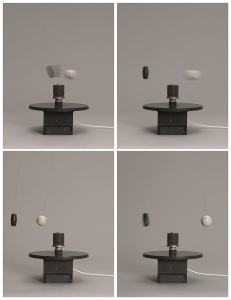ART-TRIBUTE:Takis
 Over a 70-year career, Takis (Panayiotis Vassilakis) has created some of the most innovative art of the 20th Century. A sculptor of magnetism, light and sound, he seeks out the essential poetry and beauty of the electromagnetic universe. Takis was one of the most original artistic voices in Europe from the 1960s and remains a pioneering figure today.
Over a 70-year career, Takis (Panayiotis Vassilakis) has created some of the most innovative art of the 20th Century. A sculptor of magnetism, light and sound, he seeks out the essential poetry and beauty of the electromagnetic universe. Takis was one of the most original artistic voices in Europe from the 1960s and remains a pioneering figure today.
By Efi Michalarou
Photo: Tate Archive

Takis’ solo exhibition at Tate Modern brings together over 70 works, including a rarely-seen “Magnetic Fields” installation, musical devices generating resonant and random sounds, and forests of his pivotal “Signals”. His inventions earned him the admiration of the international Avant-Garde, from William S. Burroughs and the American Beat poets to artists including Marcel Duchamp. Takis was at the forefront of kinetic art and pioneered new forms of sculpture, painting and musical structures to harness invisible natural forces. Throughout his career, he produced antennae-like sculptures called “Signals”, thin, flexible poles topped with found objects or electric lights which gently sway in response to their surroundings. His idea for these works emerged while waiting at Calais train station surrounded by “monster-eyes” going on and off in a jungle of iron”. The Signals London gallery and publication (1964-66) was named after Takis’ influential series and became an important meeting place for the transmission of ideas, breaking down boundaries between the arts and sciences. Takis fought in the Greek Resistance in WWII and the Greek Civil War (1946-49). He was intelligent and motivated, but his family did not have enough money to pay for his education. Takis taught himself by reading about science, philosophy, poetry, mythology and the arts. He decided to become an artist when he saw sculptures by Pablo Picasso and Alberto Giacometti. He was also inspired by the Ancient Greek sculptures that he saw around him in Athens. He began experimenting with plaster, making figures with elongated forms reminiscent of Giacometti’s sculptures. In 1954 Takis moved to Paris to pursue an artistic career, there he taught himself how to forge, weld and cast metal, creating small sculptures inspired by the forms of early Greek Cycladic and Egyptian art. As well as exploring new techniques and materials, Takis’s ideas about sculpture also began to change. In Paris he met avant-garde artists including Yves Klein and Jean Tinguely who were experimenting with kinetic sculpture and performance. He also connected with American Beat writers and poets whose social views and questioning of mainstream culture meshed with his own radical approach to life and art. From the late 1950s, Takis became increasingly fascinated by radar and began exploring magnetism as a way to reinvent sculpture. In 1960, he created the ephemeral action “The Impossible – Man in Space”, in which he suspended the poet Sinclair Beiles in mid-air through a system of magnets while he recited the poem “Magnetic Manifesto”. The exhibition at Tate Modern include Takis’ “telemagnetic” works, incorporating metallic objects that float with the use of magnets, such as “Magnetic Wall 9 (Red)” 1961 where abstract elements hover on the surface of a bright red canvas. Takis was an expert at manipulating electronics and mechanical components to build suspense within his art. Shown in a darkened gallery, the radiant blue light of “Télélumière No. 4” (1963-64) crackles with energy. A highlight of the exhibition is “Magnetic Fields” (1969), on display for the first time since the 1970s, in which magnetic pendulums trigger movement from nearly a hundred sculptures. Takis sourced many of his materials from military surplus shops and flea markets. From the radio antennas of US army jeeps to salvaged aeroplane gauges, he transformed technologies of warfare into monuments of beauty and contemplation. His installation “Electro-Magnetic Musical” (1966) consists of a white panel with a guitar string stretched across its width and a large needle suspended in front of it. The musical string is are attached to an amplifier and an electro magnet is concealed behind each panel. The magnets attract and repel the needles so they strike or grate against the string, creating vibrations that are amplified and played through speakers placed at the top of the panels. Takis has created new musical devices with magnets, electricity and often viewer participation, to produce sounds that he speaks of relating to the cosmos, ranging from single notes to thunderous ensembles. At the centre of the exhibition is a gallery dedicated to a sequence of Takis’ “Musicals.” The exhibition closes with “Musical Sphere” (1985) and “Gong” (1978), made from the rusted wall of a tanker. In his “Signals” from the 1970s, he incorporated various bomb fragments from the Greek Civil War gathered from the hill around his Athens studio. Takis was also involved in a number of direct political actions, particularly in the late 1960s. He was a leading participant of the Art Workers’ Coalition and his decision to forcefully remove his work from an exhibition at the MoMA in New York became a rallying point for artist rights. In Athens in 1986, he founded the “Takis Foundation – Research Center for the Art and the Sciences” which has been the home of his artistic work and research ever since.
Cover: Takis, Magnetic Wall 9 (Red), 1961, Acrylic paint on canvas, magnets, metal, cloth, nylon thread, 180 × 220 × 10 cm, Centre Pompidou, Musée national d’art moderne – Centre de création industrielle-Paris, © ADAGP, Paris and DACS, London 2019, Photo: Georges Meguerditchian
Info: Curators: Guy Brett and Michael Wellen, Assistant Curator, Helen O’Malley, Tate Modern, Bankside, London, Duration: 3/7-27/10/19, Days & Hours: Sun-Thu 10:00-18:00, Fri-Sun 10:00-22:00, www.tate.org.uk





